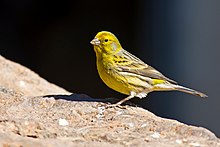| Atlantic canary | |
|---|---|

| |
| Male in Gran Canaria, Spain | |
| Scientific classification | |
| Domain: | Eukaryota |
| Kingdom: | Animalia |
| Phylum: | Chordata |
| Class: | Aves |
| Order: | Passeriformes |
| Family: | Fringillidae |
| Subfamily: | Carduelinae |
| Genus: | Serinus |
| Species: | S. canaria
|
| Binomial name | |
| Serinus canaria | |
| Synonyms | |
|
Fringilla canaria Linnaeus, 1758 | |
The Atlantic canary (Serinus canaria), known worldwide simply as the wild canary and also called the island canary, common canary, or canary, is a small passerine bird belonging to the genus Serinus in the true finch family, Fringillidae. It is native to the Canary Islands, the Azores, and Madeira. It has two subspecies: the wild or common canary (Serinus canaria canaria) and domestic canary (Serinus canaria domestica). Wild birds are mostly yellow-green, with brownish streaking on the back. The species is common in captivity and a number of colour varieties have been bred.
This bird is the natural symbol of the Canary Islands, together with the Canary Island date palm.[2]
- ^ BirdLife International (2018). "Serinus canaria". IUCN Red List of Threatened Species. 2018: e.T22720056A132137153. doi:10.2305/IUCN.UK.2018-2.RLTS.T22720056A132137153.en. Retrieved 19 November 2021.
- ^ Símbolos de la naturaleza para las Islas Canarias [Natural Symbols for the Canary Islands] (Ley 7/1991) (in Spanish). Vol. 151. 30 April 1991. pp. 20946–20497 – via BOE.
